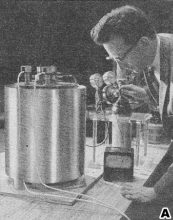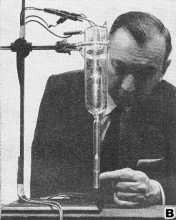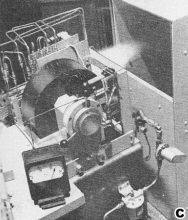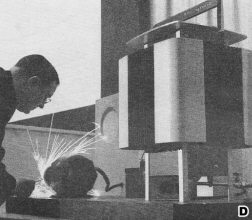Four New Sources of Power |
|
When this "Four New Sources of Power" article appeared in Radio−Electronics magazine in 1960, most people had never heard of a fuel cell, the Seebeck effect, thermionic effects, or magnetohydrodynamics. All had been around as features embedded in common products in some manner, like thermionics in vacuum tubes. It is pointed out that Sir Humphrey Davy invented the fuel cell technique in 1802, thermoelectricity by Thomas Seebeck in 1821, thermionic effects by Thomas Edison in 1878, and magnetohydrodynamics by Michael Faraday in 1831. Today, all four types of power sources have been integrated into a host of products. Whereas thermionics was among the most common in 1960, it might be the least common of the four nowadays. Four New Sources of Power
The devices that were demonstrated produced direct current at potentials ranging from a fraction of a volt to about 30 volts, and powers from 0.2 watt to 5 kilowatts. At present all are highly experimental, and electricity produced by them is far more costly than by conventional methods. But even now one or another of these generators may be economic for certain applications, such as those in which noise or vibration cannot be tolerated, or for use in remote areas (the Russians sell a kerosene-powered thermoelectric generator to operate a radio in remote areas).
This magnetohydrodynamic generator (see Radio-Electronics, January, 1960, page 8) blasts ionized gas through a magnetic field at velocities from 1,000 to 2,000 miles per hour to generate current. The generator shown (C) produces about 1 watt - a larger unit demonstrated at the same time was capable of 5-kw output. The thermoelectric generator at D consists of a large number of thermocouples, uses propane gas for heating. It produces 100 watts. A 1,000-watt unit-powered by nuclear fuel-is under construction. Thermionics - Thomas Edison was an American inventor and businessman born in 1847 and died in 1931. He is widely regarded as one of the most prolific inventors in history, and is best known for his development of the practical incandescent light bulb. Edison's work in electrical power generation and distribution systems, as well as his inventions in fields such as telegraphy, phonography, and motion pictures, had a profound impact on the world and helped to shape the modern era. He is often referred to as the "Wizard of Menlo Park" in reference to his laboratory in New Jersey, where he developed many of his most important inventions. In addition to his inventions, Edison was also a savvy businessman, and he held over 1,000 patents for his inventions. He was a tireless worker, who spent long hours in his laboratory and was known for his ingenuity and perseverance. Edison's contributions to science and technology continue to be celebrated today, and he remains an inspiration to inventors and entrepreneurs around the world. Thermionics is a subfield of electronics that deals with the study and application of thermally-generated electrons and their behavior in vacuum tubes and solid-state devices. It involves the generation, control, and measurement of the flow of electrons in vacuum tubes and other devices that rely on thermionic emission. The study of thermionics is important in the design and development of vacuum tube electronics, such as amplifiers, oscillators, and rectifiers, as well as in the development of thermionic power generation systems. Seebeck Effect - Thomas Johann Seebeck was a physicist and mathematician from Estonia who was born in 1770 and died in 1831. He is best known for the discovery of the Seebeck effect, which is now known as thermoelectricity or thermoelectric effect. The Seebeck effect is the generation of a voltage difference in a conductor as a result of a temperature difference between its two ends. Seebeck discovered this phenomenon while conducting experiments on the relationship between temperature and electromotive force. His work laid the foundation for the development of thermoelectric devices, such as thermocouples and thermoelectric generators, which are used to convert heat into electrical energy or to measure temperature differences. Today, Seebeck's discovery is widely recognized as a major milestone in the field of thermoelectricity, and his name is remembered as one of the pioneers of this field of study. The Seebeck effect is a thermoelectric phenomenon that describes the generation of a voltage difference in a conductor as a result of a temperature difference between its two ends. It is named after Thomas Seebeck, who first discovered the effect in 1821. The Seebeck effect occurs in any material that has a temperature-dependent electrical conductivity, and is the basis for the operation of thermoelectric devices, such as thermocouples and thermoelectric generators. In thermoelectric devices, the Seebeck effect is used to convert heat into electrical energy, or to measure temperature differences by detecting the voltage difference generated by the Seebeck effect. The magnitude of the voltage generated is proportional to the temperature difference, making the Seebeck effect a useful tool for temperature sensing and measurement. Fuel Cell - Sir Humphrey Davy was a British chemist and inventor born in 1778. He is best known for his pioneering work in the field of electrochemistry, and for his discovery of several chemical elements, including sodium and potassium. Davy was also a renowned inventor and is credited with inventing the first electric lamp, known as the Davy lamp, which was used in coal mines to provide a safe source of light. He was a prolific writer and his work "Elements of Chemical Philosophy" was a major contribution to the understanding of the science of chemistry. Davy was a fellow of the Royal Society, and was awarded several honors and awards throughout his lifetime, including being knighted by King George IV in 1812. He died in 1829 and is remembered today as one of the greatest scientists of his time. A fuel cell is a type of energy conversion device that converts the energy from a chemical reaction into electrical energy. It operates by bringing a fuel, such as hydrogen, and an oxidant, such as oxygen, into close proximity, allowing them to react together to generate an electrical current. Unlike batteries, fuel cells do not store energy, but instead generate electrical energy continuously as long as the fuel and oxidant are supplied. Fuel cells are highly efficient, with little waste heat, and are considered a clean source of energy because the only byproduct of their reaction is water. Fuel cells are used in a variety of applications, including powering vehicles, providing backup power, and generating electricity for residential and commercial use. There are several types of fuel cells, each with unique features and applications, including proton exchange membrane fuel cells (PEMFCs), solid oxide fuel cells (SOFCs), and phosphoric acid fuel cells (PAFCs). Magnetohydrodynamics - Michael Faraday was an English scientist born in 1791 and died in 1867. He was a pioneering physicist and chemist, who made important contributions to the fields of electromagnetism and electrochemistry. Faraday is best known for his discovery of electromagnetic induction, which showed that a changing magnetic field can induce an electric current in a conductor, and for his laws of electrolysis, which describe the relationships between electric current, chemical reaction, and electrochemical equivalents. Faraday's work laid the foundation for the development of many important technologies, including the electric motor, the transformer, and the dynamo. Faraday was a self-taught scientist and made his discoveries through a combination of meticulous experimentation and a deep understanding of the underlying physical principles. He was a devout Christian and was known for his clear explanations of scientific concepts, which made his ideas accessible to a wide audience. Faraday is remembered as one of the greatest scientists of all time and his work continues to shape our understanding of the natural world. Magnetohydrodynamics (MHD) is a branch of physics that studies the behavior of electrically conducting fluids in the presence of magnetic fields. It encompasses the interplay between the magnetic forces and the fluid dynamics, and is relevant to many areas of science and engineering, including plasma physics, astrophysics, geophysics, and fusion energy research. In MHD, the motion of the fluid is coupled to the magnetic field, leading to complex interactions and phenomena, such as magnetic reconnection, Alfvén waves, and the Parker spiral in the solar wind. MHD is also used to model and understand the behavior of plasmas in fusion reactors, where high temperatures and pressures are used to generate fusion reactions between light elements. The principles of MHD have a wide range of applications, including the design and operation of fusion reactors, the study of space plasmas, and the understanding of geomagnetic processes in the Earth's core.
Posted February 8, 2023 |
|




